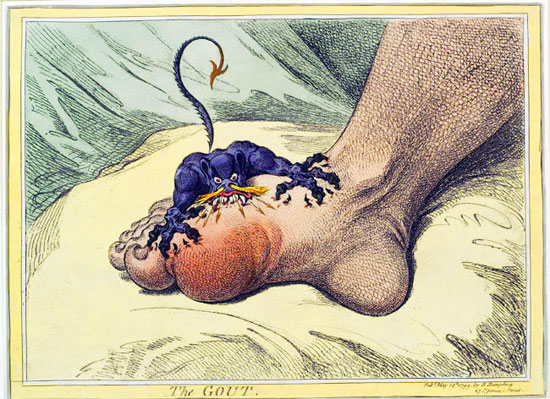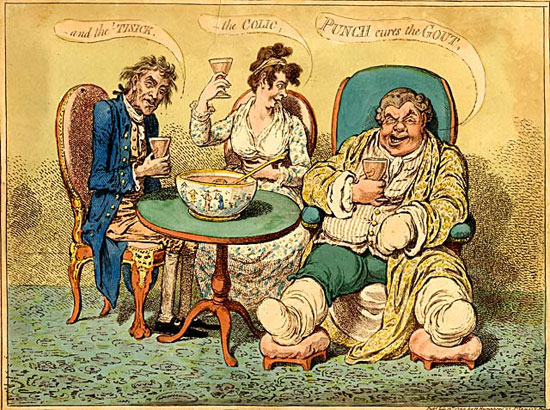
Monday, May 30, 2005A lesson in foot pain (text and images stolen from http://www.healthsystem.virginia.edu/uvahealth/adult_arthritis/gout.cfm) What is gout? Gout is characterized by inflamed, painful joints due to the formation of crystal deposits at the joints. Also known as "the disease of kings and the king of diseases," gout affects more men than women and is often associated with obesity, hypertension (high blood pressure), hyperlipidemia (high levels of lipids in the blood), and diabetes. What causes gout? Gout is caused by monosodium urate crystal deposits in the joints, due to an excess of uric acid in the body. The excess of uric acid may be caused by an increase in production by the body, under-elimination of the uric acid by the kidneys, or increased intake of certain foods that metabolize into uric acid in the body. Foods that are high in purines (the component of the food that metabolizes into uric acid) include certain meats, seafood, dried beans, and dried peas. Alcoholic beverages may also increase levels of uric acid in the body. Gout attacks may be triggered by any/all of the following: * consumption of large quantities of alcohol * consumption of large quantities of protein-rich foods * fatigue * emotional stress * minor surgery * illness What are the symptoms of gout? Gout is characterized by sudden, recurrent attacks that often occur without warning. Severe, chronic gout may lead to deformity. The following are the most common symptoms of gout. However each individual may experience symptoms differently. Symptoms may include: * severe, sudden pain in one or more joints (most often the joint in the big toe) * swollen joint(s) * red or purplish, tight, shiny skin over joint * warmth in joint area * fever * chills * general feeling of illness * rapid heartbeat * hard lumps of urate crystal deposits under the skin (called tophi)  (text and images stolen from http://www.healthsystem.virginia.edu/internet/library/historical/artifacts/caricatures/en7-excess.cfm) Gout in Art In this 1799 hand-colored etching, James Gillray juxtaposes a popular eighteenth-century drinking song with a social commentary on the alcohol abuse of the upper class. The song is entitled, “Landlord Fill the Flowing Bowl” (also known as “Three Jolly Coachmen"). The full song can be found at http://www.firstulster.org/page/songs. One verse of the song is as follows: Punch cures the gout, the colic and the physic, Punch cures the gout, the colic and phylitic, And is to all men, And is to all men, the very best of physic. In the etching, three individuals find the medicinal cure to their ailments in the punchbowl. The bowl is filled with punch, a mixture of at least five or more ingredients of liquor and fruit juices made popular in the eighteenth century. Only the wealthy could have afforded an exquisite Chinese porcelain vessel like the one on the table. The three “jolly” characters suffer from the maladies in the song. The obese gentleman on the right is afflicted with a severe case of the gout in his extremities. Gout was believed to attack men who overindulged in heavy wines and rich foods. The man has wrapped his legs, feet, and hand in soft flannel as a means to induce perspiration, thought to be a safe and efficacious method to discharge gouty matter. William Buchan, Domestic Medicine, New York & London: Garland Publishing, Inc., 1985, pp. 484-493. The fashionable woman suffers from colic, a disease that causes pain in the bowels and costiveness. The last character is diagnosed with 'tisick, or consumption, which today is known as tuberculosis, a disease of the lungs that causes the wasting away or atrophy of the body. William Buchan, author of Domestic Medicine, wrote in 1785, “consumptions prevail more in England than in any other part of the world.” William Buchan, Domestic Medicine, New York & London: Garland Publishing, Inc., 1985, p. 218. To prevent further flair-ups of the diseases satirized in Gillray's caricature, Buchan recommended abstaining from strong liquor. These three characters in this caricature chose to ignore prevailing medical opinion and instead turned to alcohol to find relief from their symptoms. How is gout diagnosed?In addition to a complete medical history and a physical examination, a diagnosis of gout may be confirmed with the examination of a fluid sample from the joint for the presence of urate crystals. Treatment for gout: Specific treatment for gout will be determined by your physician based on: * your age, overall health, and medical history * extent of the condition * your tolerance for specific medications, procedures, and therapies * expectation for the course of the condition * your opinion or preference Treatment may include: * nonsteroidal anti-inflammatory medications (to relieve pain and inflammation) * colchicine, an oral or intravenous medication (to relieve pain and inflammation; may cause diarrhea and other side effects) * corticosteroids (to reduce inflammation) * increasing fluid intake while avoiding alcoholic beverages * reducing the intake of protein-rich foods * reducing weight (if obesity is a factor) * medication (to lower the uric acid level in the blood) * medication (to block production of uric acid in the body) * surgery (to remove extremely large tophi) posted @ 01:19 PM PDT [link] [Karma: -4 (+/-)] [2 Comments] |
cheese log bird log home blog archives post news ny times BBC news yahoo garageband pussyfoot |